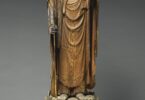Without mindfulness
of the effects of suffering,
there is no mindfulness of its causes.– Stonepeace | Get Books
 Well, it is not true at all that Buddhism focuses only on suffering. If we look into the actual contents of the Four Noble Truths, which summarise the essence of the Buddha’s teachings for beginners, only the first truth is about suffering. The second is about the causes of suffering. The third is about the end of suffering. And the fourth is about the path to the end of suffering. In this sense, Buddhism is only one-quarter about suffering – despite the word ‘suffering’ appearing four times in this context. Although highlighted in the First Noble Truth, there is no mention that we are condemned to suffer forever. Suffering is defined clearly only for recognition and comprehension, so as to lead to the Second, Third and Fourth Noble Truths – to know its causes (to uproot them), to know it can be ended (to have a target and a sense of hope), and to know how to end it (to realise True Happiness; which the opposite of suffering). If Buddhism talks only about suffering, the Buddha would have stopped teaching at the First Noble Truth!
Well, it is not true at all that Buddhism focuses only on suffering. If we look into the actual contents of the Four Noble Truths, which summarise the essence of the Buddha’s teachings for beginners, only the first truth is about suffering. The second is about the causes of suffering. The third is about the end of suffering. And the fourth is about the path to the end of suffering. In this sense, Buddhism is only one-quarter about suffering – despite the word ‘suffering’ appearing four times in this context. Although highlighted in the First Noble Truth, there is no mention that we are condemned to suffer forever. Suffering is defined clearly only for recognition and comprehension, so as to lead to the Second, Third and Fourth Noble Truths – to know its causes (to uproot them), to know it can be ended (to have a target and a sense of hope), and to know how to end it (to realise True Happiness; which the opposite of suffering). If Buddhism talks only about suffering, the Buddha would have stopped teaching at the First Noble Truth!
Sometimes, it is mistaken that we have to become perfect, exactly like Buddhas, in order to have no suffering. Of course, to attain 100% True Happiness, we do have to become Buddhas. However, there is a sliding scale – it is not all or nothing. It does not mean that we can only be totally unhappy before Buddhahood. To the extent that we practise the Dharma well, is the extent that we are happy too. This is why the Buddha also spoke about the increasingly experienceable spiritual bliss arising from progress towards enlightenment in terms of Arhathood, Bodhisattvahood and Buddhahood in many instances – to motivate us to advance towards them through cultivation of our body, speech and mind. There is also joy arising from various Dharma practices in everyday life, such as acts of generosity and meditation. In addition, in almost 300 sutras (which is about 13% of the Tripitaka), the Buddha spoke about the opposite of suffering; the Ultimate Bliss (极乐) in Amituofo’s (Amitabha Buddha) Pure Land with training there.
In the Buddhist community, there are many excellent examples of well-practised Buddhists who are visibly spiritually happy, some despite their physically long-suffering circumstances – such as great Tibetan masters living in exile. Also, the most iconic visual representation of Buddhism is the image of the Buddha smiling with calm, clear and definite happiness. So influential is it, that even many non-Buddhists find his smile aesthetically pleasing and spiritually soothing. Indeed, Buddhism is not essentially about suffering, but more on transcending it. The proof of the pudding is in the eating, as results of recent scientific studies and surveys show. With advanced neurotechnological techniques, it has been revealed that positive emotions are the strongest and most stable in diligent Buddhist practitioners – both generally (e.g. Bhutanese) and specifically, in terms of individuals (Venerable Mattheiu Ricard). These encouraging reports remind us that with practice, we will eventually realise True Happiness like the Buddhas did!
Without mindfulness
of the goal of True Happiness,
there is no mindfulness of its path.– Stonepeace | Get Books
Related Articles:
Happiest Man In The World
http://india.nydailynews.com/newsarticle/7b470adb0a9b6c32e19e16a08df13f3d/buddhist-monk-is-the-worlds-happiest-man
Happiest People In The World
http://news.bbc.co.uk/2/hi/
Happiest Nation In The World
http://www.oneworldeducation.
Related Courses:
Understanding Amituofo Via The Amitabha Sutra
https://thedailyenlightenment.com/2013/07/understanding-amituofo-via-the-amitabha-sutra-12th-run
The Mindfulness Factor: How To Be Mindful Of Buddha Purely
https://thedailyenlightenment.com/2013/07/the-mindfulness-factor-how-to-be-mindful-of-buddha-purely





Is doing bad things “built-in” in us? My conclusion is “yes” as otherwise why are there still beings who have not attained nirvana. Does the first man/woman have bad karma? This is a chicken and egg situation. If I conclude “yes”, how was the bad karma accumulated? If my answer is “No”, then this leads me to my first question. Can someone help me work this out?
The capacity to do evil is in us, but it is not fixed –
for the simple reason that there are countless Buddhas,
who realised that what truly always present is Buddha-nature –
the capacity to be good and pure.
Even before talking about Buddhahood,
we already know evil can be done away with,
by looking at many true cases of those who were evil,
who turned over a new leaf completely.
This is how humans came to be evil and thus created negative karma –
because they were not enlightened in the lives before they became humans:
https://thedailyenlightenment.com/2010/03/how-were-the-%E2%80%98first%E2%80%99-humans-%E2%80%98created%E2%80%99-part-1-sutta-summary/
This means the capacity to be evil was there.
Yet, the capacity to be pure is also there – and it is lasting –
which is why Buddhas never backslide spiritually once they realise Buddhahood.
It is like gold ore: https://thedailyenlightenment.com/2011/11/refining-gold/
The question of ‘how did we fall’ is actually misconstrued due to to this:
https://thedailyenlightenment.com/2010/04/how-did-we-fall/